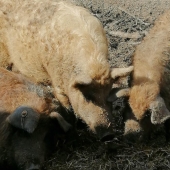




 2
2




Riley Lee wrote:So I've been making similar posts, but the title says it all.
What are some of the breeds that are fitting bill here? I try to prioritize such qualities as self sufficiency is a big key to me, and having low vet bills and low health problems helps that.
 2
2




 1
1




Laurel Jones wrote:
Riley Lee wrote:So I've been making similar posts, but the title says it all.
What are some of the breeds that are fitting bill here? I try to prioritize such qualities as self sufficiency is a big key to me, and having low vet bills and low health problems helps that.
What 2 purposes do you want? Sheep or goats? As far as I'm aware there are 2 main uses for sheep and goats. Meat, Fiber, and Milk.
 1
1




 2
2




Riley Lee wrote:I want goats! Sorry I forgot to put that, I get overexcited and just take off with no head on my shoulders. Sheep seem vulnerable, in my research, just less hardy overall, so they are not my preference.
I want them for milk and meat. Nubians seemed a good fit, but I don't know about maintenace and health.
 1
1




 3
3




Riley Lee wrote:I was under the impression sheep were more frail, health wise. Apparently that is incorrect. I prefer goats because they are browsers, and to me that means I can fit more of their food into an acre than having grazing for sheep. Perhaps I am wrong on that?
Containment wise, I have an idea for a cheap, green fence, but idk if it will work, check my profile for it. Seems like a living fence would work, as long as it gets time to be establish and the goats don't eat it themselves.
 1
1








Riley Lee wrote:I'm needing more info on the requirements off browsing vs grazing, especially in how animals can get food for either in winter. My preference for goats was the fact that, perhaps, there were some evergreen species that I could plant in pasture so that they would have year round food. I was under the impression that grazers had more trouble in winter with foraging for themselves. The idea is to have as little food inputs necessary, saving me work and money.
My fence idea is to make stabilized rammed earth of CEB and use that to build a fence, then put masonry sealer to water proof it, then perhaps put roof tar on it as well. It'd be very labor intensive, but affordable and most of the inputs can be easily bought or gathered.




 1
1








Riley Lee wrote:The stocking rates for basically hands off is low, yes, but I want to be able to provide for my animals with as little effort as possible. Not no effort, still have to make sure they are healthy and happy, but I don't want to spend time harvesting hay, silage, etc. Just let them do their thing, let genetics keep the strongest alive, and have more time for my own stuff.
 1
1








![Filename: sheepfour.jpg
Description: [Thumbnail for sheepfour.jpg]](/t/178053/a/176831/sheepfour.jpg)
![Filename: sheepone.jpg
Description: [Thumbnail for sheepone.jpg]](/t/178053/a/176832/sheepone.jpg)
![Filename: sheepthree.jpg
Description: [Thumbnail for sheepthree.jpg]](/t/178053/a/176833/sheepthree.jpg)
![Filename: sheeptwo.jpg
Description: [Thumbnail for sheeptwo.jpg]](/t/178053/a/176834/sheeptwo.jpg)
"The world is changed by your example, not your opinion." ~ Paulo Coelho

|
Message for you sir! I think it is a tiny ad:
Learn Permaculture through a little hard work
https://wheaton-labs.com/bootcamp
|



